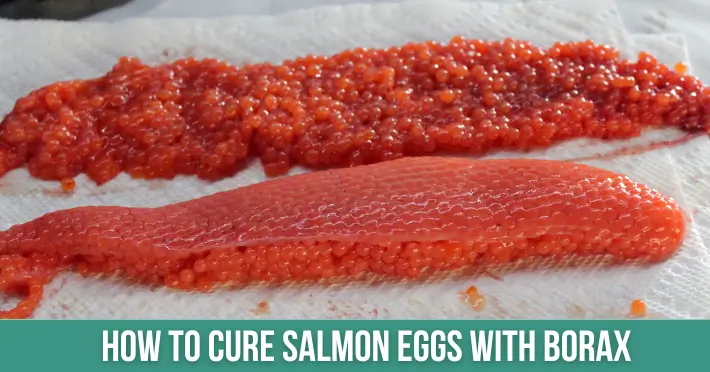Contents
- 1 How To Cure Salmon Eggs With Borax:
- 2 Materials Needed:
- 3 Mixing bowl:
- 4 Spoon or Spatula:
- 5 Stirring Tool:
- 6 Drying and Storage:
- 7 Drying and Storage:
- 8 Experimenting with additional scents:
- 9 Monitoring curing time:
- 10 FAQs:
- 11 Why should I cure salmon eggs with borax?
- 12 Can I use any type of borax for curing salmon eggs?
- 13 How do I adjust the borax quantity for curing?
- 14 What additional scents can I use in the curing process?
- 15 How long does the curing process take?
- 16 Can I store cured salmon eggs, and for how long?
- 17 Do different fish species prefer different scents?
- 18 Can I fish with cured eggs immediately after the curing process?
- 19 What should I do if the eggs are too soft or too hard after curing?
- 20 Is there a specific ratio of borax to salmon eggs to follow?
Curing salmon eggs with borax is a popular technique among anglers to enhance the durability, color, and scent of the bait. This simple yet effective method not only toughens the eggs for extended use but also adds an enticing flavor to attract fish.
In this guide, we’ll walk through the straightforward steps to successfully cure salmon eggs using borax, providing you with potent and reliable bait for your next fishing adventure.
How To Cure Salmon Eggs With Borax:
The purpose of curing salmon eggs is to enhance their durability, color, and scent for use as effective fishing bait. Curing helps toughen the eggs, allowing them to withstand the rigors of casting, trolling, and other fishing techniques.

The curing process can improve the eggs’ texture, making them more appealing to fish. The use of borax in the curing process not only aids in preservation but also imparts a distinctive scent and color to the eggs, making them more attractive to various fish species.
Overall, curing salmon eggs aims to create a potent and long-lasting bait that increases the chances of a successful fishing experience.
Materials Needed:
To cure salmon eggs with borax, you will need the following materials:
>> Fresh Salmon Eggs: Collect fresh salmon eggs for the curing process. These can often be obtained from caught fish or purchased at a local bait shop.
>> Borax: Use borax, a natural mineral compound, as the curing agent. Borax helps preserve the eggs, toughen their texture, and enhance their attractiveness to fish.
>> Mixing Bowl: Choose a large mixing bowl to hold the salmon eggs comfortably and allow for easy stirring.
>> Plastic Bags: You’ll need plastic bags to store and distribute the cured salmon eggs. Zip-top bags or vacuum-sealed bags work well for this purpose.
>> Paper Towels: Have paper towels on hand for drying the cured eggs and removing excess moisture.
>> Spoon or Spatula: Use a spoon or spatula to mix the borax with the salmon eggs evenly. This helps ensure thorough curing.
>> Storage Container: Prepare an airtight storage container for the cured eggs. This can be used to keep the eggs fresh and ready for use in your fishing endeavors.
Having these materials ready will make the process of curing salmon eggs with borax efficient and effective.
Mixing bowl:
When selecting a mixing bowl for curing salmon eggs with borax, consider the following:
>> Material: Choose a non-reactive material such as glass or stainless steel. Avoid using reactive materials like aluminum, as they may interact with the curing agents.
>> Size: Select a bowl that is large enough to comfortably accommodate the quantity of salmon eggs you plan to cure. It should provide ample space for mixing without spilling over.
>> Ease of Cleaning: Opt for a bowl that is easy to clean. Curing agents like borax can leave residues, so a bowl that is dishwasher safe or easy to hand wash is preferable.
>> Sturdiness: Ensure that the bowl is sturdy and stable. Curing involves stirring and mixing, so a bowl that won’t easily tip over is essential for a smooth process.
>> Depth: Consider the depth of the bowl. A deeper bowl can prevent splashing and make it easier to thoroughly mix the borax with the salmon eggs.
By paying attention to these factors, you can choose a suitable mixing bowl that facilitates an efficient and successful curing process for your salmon eggs.
Spoon or Spatula:
For stirring and mixing the borax with the salmon eggs during the curing process, you can use either a spoon or a spatula. Here’s a paraphrased description:
Stirring Tool:
Select an appropriate utensil, such as a spoon or spatula, for evenly mixing the borax with the salmon eggs. Ensure the tool is made of a material that won’t react with the curing agents, and choose a design that allows for thorough stirring without damaging the delicate eggs.
This utensil plays a crucial role in achieving a uniform and effective cure, contributing to the overall success of the process.
Drying and Storage:
Following the curing process, proper drying and storage are crucial to maintain the quality of the cured salmon eggs. Here’s a paraphrased description:
Drying and Storage:
After curing the salmon eggs with borax, carefully spread them on paper towels to remove excess moisture. Allow the eggs to air-dry thoroughly, ensuring they achieve the desired texture. Once dried, transfer the cured eggs to plastic bags or airtight containers for storage.
Properly sealed containers help preserve the enhanced scent and durability of the cured eggs. This systematic approach to drying and storage ensures that the cured salmon eggs remain in optimal condition, ready for use during your fishing activities.
Experimenting with additional scents:
Experimenting with additional scents while curing salmon eggs with borax can be a creative way to enhance their appeal to fish. Here are some ideas for adding scents to your cured salmon eggs:
>> Anise Oil: Anise has a strong licorice-like scent that can be attractive to certain fish species. A few drops of anise oil added to the curing mixture can impart a distinctive aroma.
>> Garlic Powder: Garlic is known to be an effective fish attractant. Incorporating a small amount of garlic powder into the curing process can add an enticing scent to the eggs.
>> Shrimp Oil: Shrimp oil is a natural scent that can mimic the smell of prey in the water. Adding a few drops of shrimp oil to the curing mixture can make the eggs more appealing to a variety of fish.
>> Vanilla Extract: Vanilla has a sweet scent that might attract certain fish. A small amount of pure vanilla extract can be added to the curing mixture for a subtle and sweet aroma.
>> Crayfish Scent: If crayfish are part of the natural diet of the fish you are targeting, consider adding a crayfish-scented additive to the curing mix.
>> Commercial Fish Attractants: Explore commercial fish attractants available in stores. These products are specifically designed to lure fish, and you can experiment with incorporating them into your curing process.
When experimenting with additional scents, start with small amounts to avoid overpowering the natural scent of the salmon eggs. It’s a good idea to keep detailed notes on your experiments to understand what works best for the specific fish species you are targeting. Adjust the quantities and combinations based on your observations and preferences.
Monitoring curing time:
Monitoring the curing time is crucial to achieving the desired texture and effectiveness of the cured salmon eggs. Here are some guidelines for effectively managing the curing time:
>> Follow the Recipe: Adhere to the specific recipe or guidelines you are using for curing salmon eggs with borax. The recommended curing time will depend on the amount of borax used and the desired outcome.
>> Regular Checks: Periodically check the progress of the curing process. Assess the texture, color, and scent of the eggs at intervals to ensure you achieve the desired results.
>> Adjustment: If the eggs are not curing as expected, consider adjusting the curing time. You may need to extend or reduce the time based on factors such as room temperature, egg size, and the specific curing recipe.
>> Room Temperature: Curing times can be affected by the ambient temperature. Warmer temperatures may expedite the curing process, while cooler temperatures may slow it down. Be mindful of the room temperature and adjust the curing time accordingly.
>> Texture Testing: Perform texture tests by squeezing or pressing a few eggs between your fingers. The eggs should have a resilient, firm texture without being overly stiff. Adjust the curing time if the eggs are too soft or too hard.
>> Color and Scent: Evaluate the color and scent of the cured eggs. If you find the color isn’t vibrant or the scent isn’t sufficiently appealing, you might need to extend the curing time.
>> Experience and Experimentation: Over time, you’ll develop a sense of the optimal curing time based on your preferences and fishing conditions. Experiment with different curing times to find what works best for you.
>> Documentation: Keep a record of your curing experiments, noting the curing time, ambient temperature, and any adjustments made. This documentation will help you refine your process for future batches.
By actively monitoring the curing time and making adjustments as needed, you can ensure that your salmon eggs are effectively cured and optimized for successful fishing.
Conclusion:
Curing salmon eggs with borax is a straightforward yet effective method to enhance their durability, color, and scent for use as potent fishing bait. By following the outlined steps, anglers can create a resilient and attractive bait that increases the chances of a successful fishing experience.
Experimenting with additional scents and carefully monitoring the curing time allows for customization, ensuring the optimal outcome for different fishing conditions. With attention to detail and some experimentation, anglers can produce high-quality cured salmon eggs ready to entice a variety of fish species. Happy fishing!
FAQs:
Why should I cure salmon eggs with borax?
Curing with borax toughens the eggs, making them more durable for fishing. It also enhances color and imparts a distinctive scent, attracting fish.
Can I use any type of borax for curing salmon eggs?
Yes, commonly available borax, such as the laundry detergent variety, is suitable for curing salmon eggs.
How do I adjust the borax quantity for curing?
Experiment with small batches and adjust the borax quantity based on personal preference. More borax may yield firmer eggs, while less can result in softer texture.
What additional scents can I use in the curing process?
Anise oil, garlic powder, shrimp oil, vanilla extract, and commercial fish attractants are popular choices. Experiment with small amounts to find the preferred scent.
How long does the curing process take?
Curing times vary based on factors like room temperature and personal preference. Regularly check the eggs’ texture, color, and scent, adjusting the time as needed.
Can I store cured salmon eggs, and for how long?
Yes, store cured eggs in airtight containers or bags in the refrigerator. Properly cured eggs can last for weeks, providing a convenient and ready-to-use fishing bait.
Do different fish species prefer different scents?
Yes, various fish species may be attracted to different scents. Experimentation and local knowledge can help tailor the cured eggs to the preferences of specific fish.
Can I fish with cured eggs immediately after the curing process?
While you can fish with the cured eggs right away, some anglers prefer to let them air-dry for a day to further enhance their texture and durability.
What should I do if the eggs are too soft or too hard after curing?
Adjust the curing time accordingly. If the eggs are too soft, extend the time; if too hard, reduce it. Regular monitoring and adjustments will help achieve the desired texture.
Is there a specific ratio of borax to salmon eggs to follow?
Ratios can vary, but a common starting point is 1 part borax to 3-4 parts salmon eggs. Adjustments can be made based on personal preference and experimentation.







